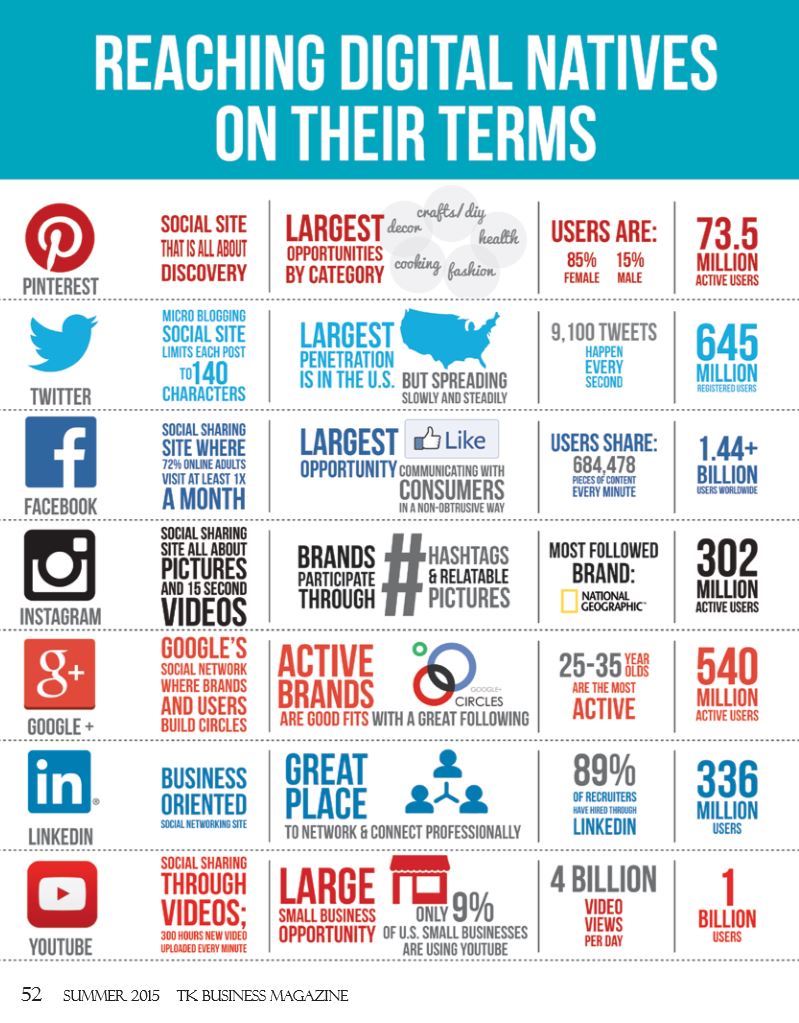Social Media & Mobile Technology in the Business Environment
By Dr. Pamela J. Schmidt Washburn University
They stress that organizations need to stimulate and facilitate change to handle accelerated change in the business environment. In particular, they urge companies to:
• Keep in touch with their environment. • Learn about new practices and technologies. • Reward experimentation.
To assist entrepreneurs and companies in reaching new customers, this article suggests ways to benefit from current technology-related trends in social media and mobile computing.
DIGITAL NATIVES First, get to know Generation Y (i.e. Millennials, who were born between the early 1980s and 1999) and Generation Z (born between late 1990s to date). Gen Z are considered ‘digital natives’ who literally grew up with the Internet, computers and email as their consent companions. Not just heavy users of technology, they experience technology as a natural extension of themselves. These two groups already make up a sizable portion of the consumer base of today and tomorrow. Businesses need to communicate directly to them and attract them as customers.
These digital natives are best reached through a changing array of social media that currently includes: YouTube, Facebook, LinkedIn, Twitter, Instagram, Tumblr and Pinterest. This list will continue to change with ever-emerging Internet websites and smartphone apps.
SOCIAL MEDIA STRATEGY Make sure your company has a social media strategy with the right targeted presence online, or start experimenting with social media technologies now. Don’t miss the chance to add value and grow your business by sharing online.
For example, both informative and ‘how-to’ videos (yes, from companies) are frequently posted on youtube.com alongside all the entertainment and personal video experiments. Companies can engage customers by offering useful or interesting content to build name recognition and brand awareness. Don’t overlook the YouTube video outlet as streaming media are now overshadowing traditional video and television among Gen Y and Gen Z.
Peer reviews carry much influence in this group. Do you know your company’s online reputation? What is shared online in reviews about your company? Reviews and ratings can be found on sites like Amazon.com, Angie’s list, on blogs and intermediary sites in your industry.
Your companies’ PR and media staff need to continually scan online social media for postings online. An essential function of public relations is now to ensure follow-up of online consumer comments. Companies need to ‘right the wrongs’ as strong and lasting impressions are formed by reviews online.
THE PROSUMER MARKET Not long ago, costly inventions and new technology were only accessible to a few wealthy individuals or to wellfunded business in a specialized business category. Think of the early business computers or professional 35-millimeter film-cameras that required photography studios and film editing suites in order to produce a watchable movie. Today, a wealth of high-quality media technology puts great creative and production power into the hands of non-professionals.
In his 1980 future trends book “The Third Wave,” Alvin Toffler coined the term “prosumer” as someone who blurs the distinction between a consumer and a producer. Modern technological advances such as micro-technology miniaturization, digital optics, flash memory and pervasive wireless networking have led to development of affordable high-quality prosumer tools that allow non-professionals to become proficient producers of online content. These same technology tools are at the command of innovative companies ready to experiment with new ways to seek out these digital generations on their own ‘online turf.’
Companies need to find are talented individuals who can reach out to interact in social media on behalf of the company and its consumer base. Relational marketing is the new approach and social media is well suited to this approach.
OUR MOBILE LIFESTYLE In the USA today, two-thirds of individuals carry a smartphone. Not stopping there, Americans are tech-laden with multiple computing devices—an average of four devices per person. About 30 percent now have a tablet, up from just 5 percent two years ago. But most of us have not given up our personal computer—many just prefer to be mobile when away from the workplace and increasingly while in the workplace. Outcomes of this trend include an explosion of self-made media on mobile devices along with quick online sharing.
Marketing and advertising has entered the age of “narrow-casting” (i.e. narrowly targeting audiences online based on specific interests or their needs of the moment). Consumers are ‘pulling’ information and entertainment on a ‘when needed’ basis versus the traditional ‘push’ of broadcast network television, print media and radio.
Amidst this wealth of Internet communication channels, a company should hone its strategy to make better use of new media.
• Identify and target your audience by clearly meeting their needs and anticipating their wants. • Find creative and interesting ways to support consumers while sharing your company’s message in entertaining and helpful ways. • Figure out exactly who your target customer base really is, then determine where online to help them find you.
Different channels can be used online in addition to broadly appealing sites like YouTube. Males tend to interact with online gaming sites and sport sites (think fantasy football leagues online). Females gravitate more to social, design and collaborative online outlets. If your industry or products are fast changing, then keep putting out new content – it encourages and attracts repeated visits and views.
A company of any size can create electronic content (websites, blogs, video, social media postings, etc.) to enhance its strategy, corporate image and business operations. A firm does not have to be a big player to utilize these technology tools. Yet, firms of all sizes risk disruption and possible failure if they do not keep pace by leveraging what new technologies have to offer.
MOBILE-FRIENDLY CONTENT Mobile traffic has become so prevalent that in April 2015 Google changed how it ranks search results generated from mobile devices. Now, when a search originates from a mobile device such as a smartphone, the search results give priority to ‘mobile-friendly’ websites over those of non-mobile ready sites. This provides the mobile user with more useful search results that do not have to be scrolled or enlarged. This criterion does not affect searches initiated from non-mobile devices, but it is important to realize that the majority of searches today are from mobile devices.
ComScore reports that 60 percent of online traffic is now generated by mobile devices. Furthermore, during the last holiday shopping season, nearly 60 percent of Amazon customers shopped using a mobile device. For an effective commercial presence on the Internet, or even just to be discovered by a majority of consumer searches targeting your industry, firms need to have a mobilefriendly web presence.
To determine whether a webpage meets Google's new mobile-friendly criteria, you can enter its name at Mobile-Friendly Test page [https:// www.google.com/webmasters/tools/ mobile-friendly/]. Along with a resulting assessment, the site also provides links to advice on how to achieve mobile-friendly design.
TECHNOLOGICAL DISRUPTION As technology continues to change, there will be both disruptions of existing businesses as well as opportunities for innovation to create new businesses. Looking back in the past two decades, we can easily find examples where technology has disrupted major industries. Take the music industry for example. Vinyl records gave way to Music CDs, which all but disappeared with the introduction of the innovative, but now obsolete, iPod, which debuted in 2001. Streaming and downloaded digital content has completely disrupted the former physical media-based music business. Now when people want to get music, they can buy and download it from iTunes or Amazon. Or, no need to buy it at all. Just stream music online from Pandora, Spotify or a host of other music-streaming sites.
Now, the traditional cable television business is under siege by streaming video from Netflix, Hulu, Apple TV and others. Do you recall when CATV disrupted the earlier broadcast network TV?
If you want to keep up with the changing landscape of business, create an organization that strives to facilitate change and stimulates innovation. Continually scan the environment, learn new technologies and adopt best business practices. Seek out digital natives to help your company adapt. Yes, and remember to reward their social media experimentation.
As Brian Solis urges us—disruptive technology is catalyst for change, not the reason that change occurs. If our approach does not adapt and take advantage of new advances, then someone else more agile, adaptable and experimental will take advantage of it. Let’s not go the way of many brick and mortar bookstores, the vinyl record, the VCR or the dinosaur. Don’t be left behind on the technology curve, ride it like a big Hawaiian surf—on to the next technology wave.
TK




